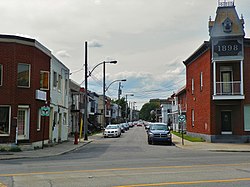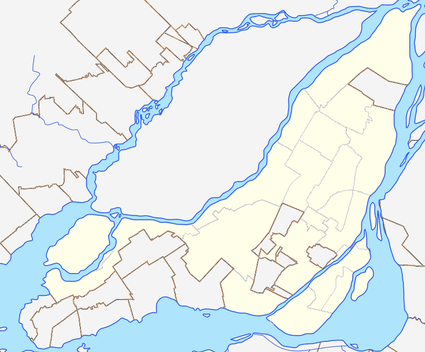Mercier-Est
Mercier-Est (French pronunciation: [mɛʁsje ɛst]), commonly referred to as Tétreaultville (French pronunciation: [tetʁovil]) is a neighbourhood of Montreal, Quebec.
Mercier-Est Tétraultville | |
|---|---|
 Lepailleur street in Mercier-Est. | |
 Mercier-Est Location of Mercier-Est in Montreal | |
| Coordinates: 45.5958°N 73.5163°W | |
| Country | Canada |
| Province | Quebec |
| City | Montreal |
| Borough | Mercier–Hochelaga-Maisonneuve |
Geography
Mercier-Est is an inner-city neighbourhood located in the east end of the Island of Montreal. It is one of three districts in the Mercier-Hochelaga-Maisonneuve borough (the other two are Mercier-Ouest and Hochelaga-Maisonneuve). It is more commonly referred to as 'Tétreaultville', although this label is not entirely accurate. Tétreaultville consists more precisely of the eastern portion of what is now Mercier-Est while the western portion was initially part of the Longue-Pointe village. The construction of Autoroute 25 isolated the western portion, and so Tétreaultville came to refer to the entire area east of the highway (officially named Mercier-Est). Mercier-est is mainly composed of working class Québécois with a notable presence of Italians in the North-Eastern portion around Sherbrooke street. It is bordered by the borough of Anjou to the north, Mercier-Ouest district to the west, the St. Lawrence River to the South and the town of Montreal-Est to the east. Limited by Autoroute 25 to the west and water-bound to the south, Mercier-Est is somewhat isolated and lacking an efficient north-south transit corridor. This may be one of the underlying causes for the neighbourhood's deteriorating infrastructure, decreased family occupancy, commercial vacancy and population exodus. There are signs that this trend may have reversed recently with new infrastructure projects, revitalization projects and other attempts to make the neighbourhood more attractive for young families. The neighbourhood is served by the Honoré-Beaugrand metro station.
History
Beginning in 1665, colonists began working the land and built a rural community. The region was initially called Longue-Pointe which encompassed both Mercier-Ouest and Mercier-Est districts. Urbanization began in 1890, and Longue-Pointe become an industrial city by the early 20th century (between 1900–1910). This social transformation was induced by the arrival of large industries in the western portion of Longue-Pointe and the building of a tramway on Notre-Dame Street. However, the neighbourhood's social and economic character was vastly transformed during the urban planning of the 1960s in Montreal in anticipation of Expo 67. The Minister of transport announced the plan to build the Autoroute 25 permanently dividing Longue-Pointe into its respective east and west districts. Large commercial centers filtered out small businesses. The extension of the metro and elimination of the tramway exacerbated industrial activity, and the remnants of the rural landscape of Longue-Pointe disappeared. Citizens battled against the urbanization plans of the 1960s in hopes of preserving their village community. The only success they had is limited the Montreal's port's expansion along the St. Lawrence River in Mercier-Est. They preserved the promenade Bellerive south of Notre-Dame Street in Mercier-Est.[1]
Since 1987, Mercier-Est has become well known for social mobilization against government projects intended to intensify industrialization. Social organization still exist today. Solidarité Mercier-Est is an example of citizen's groups fighting against gentrification, further urbanization and industrialization. Their activism is focused toward the RUI Integrated Urban Renewal and Contrecoeur projects currently underway in the district.[1]
Urban Renewal
During the 2002 Montreal Summit, the municipal government put territorial plan-based action to fight poverty. The approach focused on urban revitalization as well as more integrated development. Mercier-Est, consequently, has received attention. The changing dynamic of its social fabric is troubling. There is a constant aging of the population and is being replaced by individual renters as the neighbourhood is unattractive for young families. Over the years there has been a steady increase in the number of single-parent families, the majority headed by women.[1] Low-income households are pervasive and rising, making it difficult for the neighbourhood to go through any 'natural' revitalization. Subsequently, the government has taken action with two notable development projects. The first addresses the need for economic revitalization in the area while the second addresses the housing issue for low-income Montrealers.
RUI Plan
In December 2005, Mercier-Hochelaga-Maisonneuve proposed Mercier-est as a candidate for Urban renewal projects already underway in Hochelaga-Maisonneuve and other neighbourhoods in the Sud-Ouest borough[1] The outcome was the proposed RUI-Mercier-est project. RUI, short for 'Revitalisation Urbaine Integree' or 'Integrated Urban Renewal' targets the south portion of the neighbourhood under Hochelaga street. The project noted worrying trends about the neighbourhood in general. Problematic areas included a continuously aging population, increased construction of smaller dwellings, family exodus, increased number of single occupancy and a growing low-income population well under the Montreal average. However, this is not to take away from its advantages which could be conducive to effective revitalization: large number of parks, increased use in public transportation and commercial axes at the heart of the district.[1] The project wishes to address the barriers connecting Mercier-Est to the west (notably Mercier-Ouest). The southern portion of the neighbourhood is 'locked-in' by the Autoroute 25 to the west, heavy industrial sectors to the east and the St.Lawrence river to the South. The northern portionof Mercier-Est is better connected to services and commercial centers, so the RUI plan wishes to supplement a north-south transportation within the district. The train tracks, just south of Hochelaga street on Souligny provide another barrier to this north-south axis.[2]
Contrecoeur Housing Project
Contrecoeur is an empty 38 hectare field at the northeastern limit of Mercier-Est. It is bordered by Anjou to the north and Montreal's oil refineries to the east. It has been abandoned since the 1950s, but Montreal has given a construction mandate to SHDM and SDM to construct 1700 housing units, 63% of which are social and affordable housing (39% affordable, 24% social). In addition, there will be land used as a commercial site for small businesses and offices. Construction will commence in 2008 to include 443 single family homes, 102 of which are single-detached (in the northern section bordering Anjou) and the remaining a combination of attached and row housing. 656 affordable-plex units will be built between Rousseau and de Grosbois street as well as an additional 407 social housing units dispersed across the site south of Rousseau street and heavily concentrated around de Grosbois street and Sherbrooke street. There will also be 177 private apartment units for retired seniors just north of Sherbrooke street.[3] With an area of 0.38 square kilometers and the arrival of 4000-5000 inhabitants, the project's density will vary between 10526 and 13157 inhabitants per square kilometer. 1271 units will be built south of Rousseau street while the remaining 413 units will be found north of Rousseau.[3] The project's progressive density heading south towards Sherbrooke street together with the increased concentration of social housing may have detrimental effects on crime, poverty and social harmony. Residents have complained about this proposal, citing the high density and height of the proposed structures as unacceptable.[3] However, the project's main worry is ensuring a sane cohabitation with the heavy industry located just east of the project.
See also
- List of neighbourhoods in Montreal
- Municipal reorganization in Quebec
References
- (in French) "Agir Ensemble dans Mercier-Est" Plan de Revitalisation Urbaine Integree, Avril 2007
- (in French) "Agir Ensemble dans Mercier-Est" Plan de Revitalisation Urbaine Integree, Avril 2007 p.18
- (in French) "Plan du Directeur de Developpement du site Contrecoeur" Office de Consultation Publique de Montreal, Aout 2007